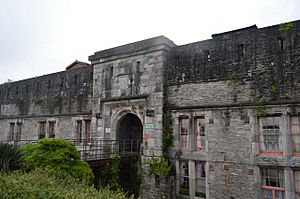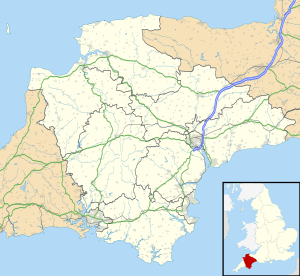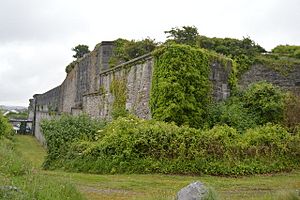Stamford Fort facts for kids
Stamford Fort is an old fort from the 1800s. It was built to help protect the city of Plymouth in England. It was part of a big plan to defend important places in Britain. This fort sits high up, about 165 feet above the sea, between Jennycliffe Bay and Hooe Lake.
Contents
Stamford Fort: A Historic Defender
Why Was Stamford Fort Built?
Stamford Fort was built because of a special report in 1859. This report said Britain needed better defenses. The fort was part of a huge project called the Palmerston Forts. These forts were named after the Prime Minister at the time, Lord Palmerston, who strongly supported building them.
The main job of Stamford Fort was to protect the eastern side of Plymouth. It was especially important for guarding the Royal Naval Dockyard at Devonport. This dockyard was a vital place where naval ships were built and repaired.
How Was the Fort Designed?
Captain Edmund Frederick Du Cane designed Stamford Fort. It was built by a company called George Roach and Company. They also built another nearby fort called Staddon Fort.
Stamford Fort has five sides, like a polygon. It was surrounded by a dry ditch. This ditch was a big trench without water. Three sides of the fort faced the land, one faced the sea, and the back faced an area called the Cattewater.
The dry ditch was protected by three special structures called Caponiers. These were small forts inside the ditch that could fire at attackers. There was also a gallery (a long passage) on the opposite side of the ditch. The fort was connected to nearby Staddon Fort by a military road.
Inside the fort, there was a barrack block for 200 soldiers. This building had 13 rooms, called casemates, on two floors. These rooms are now used as private flats.
What Weapons Did It Have?
Stamford Fort was designed to hold 20 large guns and 6 mortars. Mortars are weapons that fire shells high into the air. By 1893, the fort had several powerful guns. These included five 64-Pounder Rifled Muzzle Loading Guns. It also had one 7-inch Rifled Breech Loading (RBL) gun. Plus, there were two 10-inch Rifled Muzzle Loading (RML) guns.
What Happened to the Fort?
By the early 1900s, new military technology made forts like Stamford Fort less useful. It was no longer needed for defense and its weapons were removed in 1904.
The War Office, which managed military property, sold the fort in 1963. Today, Stamford Fort has new uses. It is now a caravan park, a fitness center, and has private flats. In 1963, it was given a special status as a Grade II listed building. This means it's an important historic place that needs to be protected.




